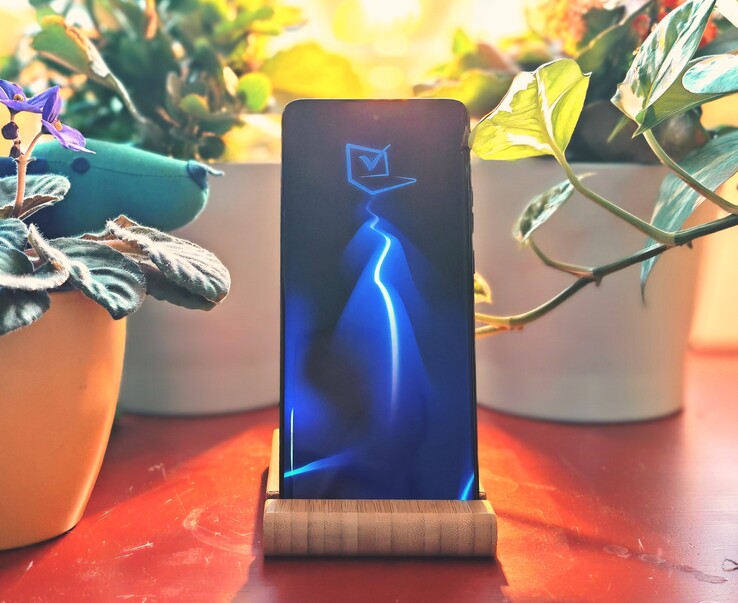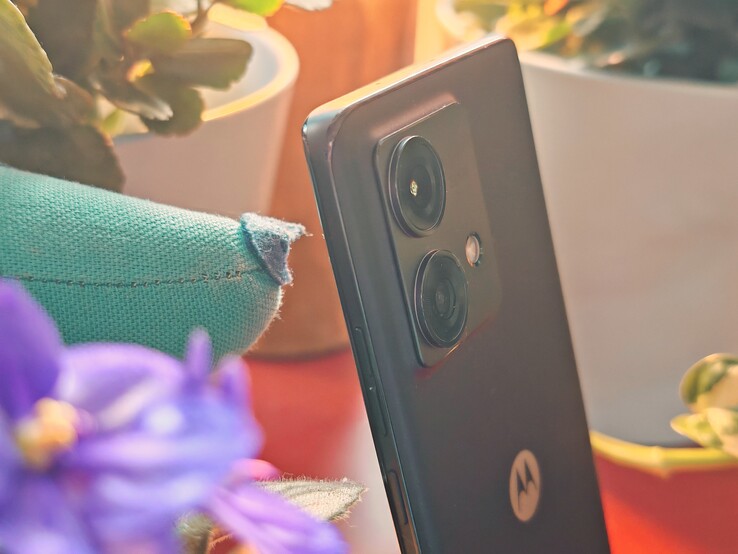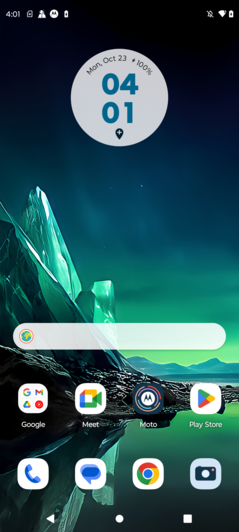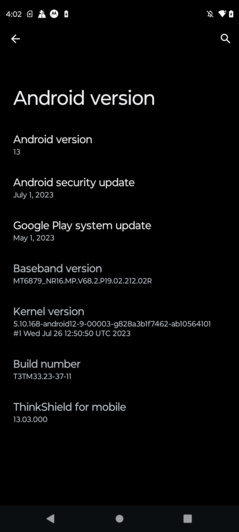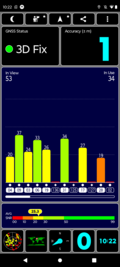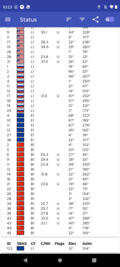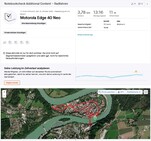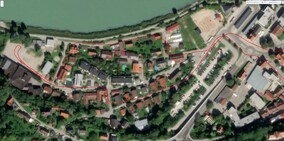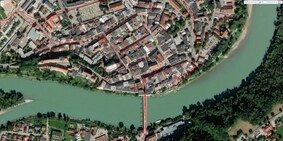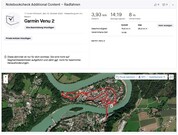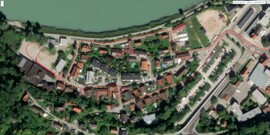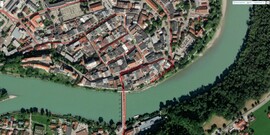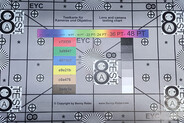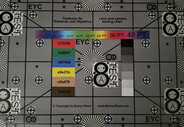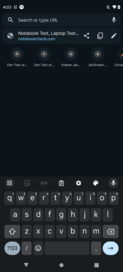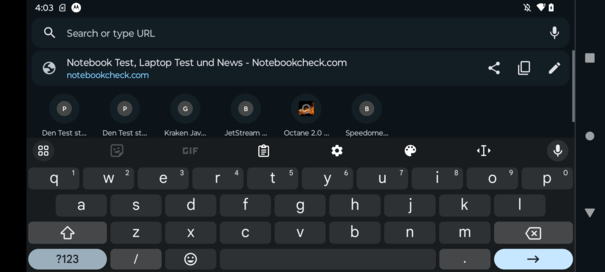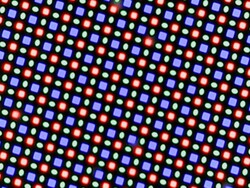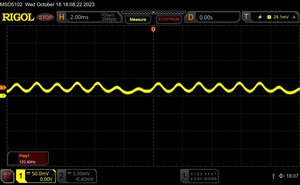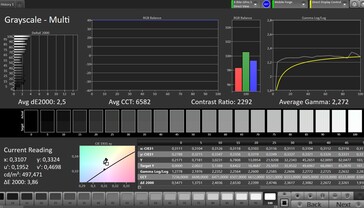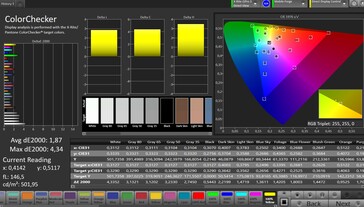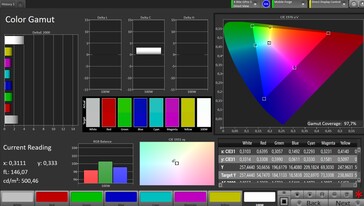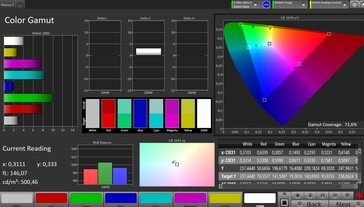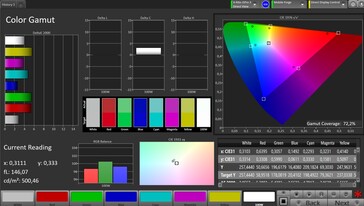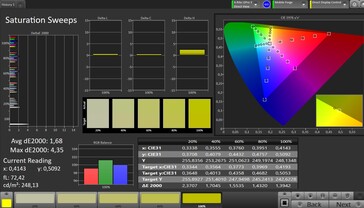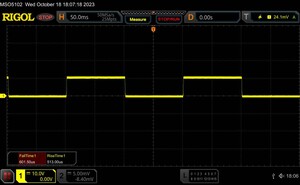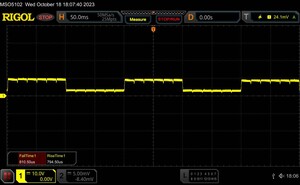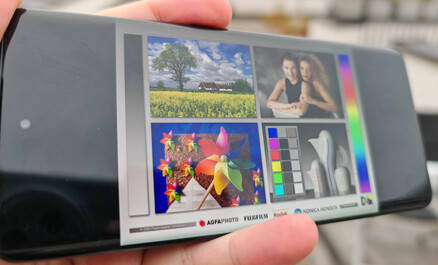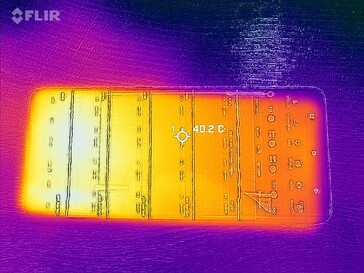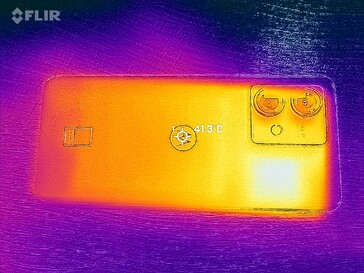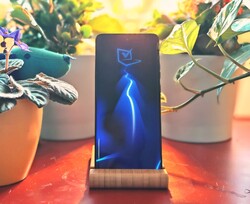Motorola Edge 40 Neo smartphone review – The US$550 phone with high-end features
The Edge series usually consists of Motorola's best smartphones, and the Edge 40 Neo bridges the gap between mid-range and high-end phones. It supposedly masters a whole range of features normally seen on much more expensive phones — without breaking the bank.
Costing around US$550, it is indeed a mid-range smartphone but it still boasts a 144-GHz OLED screen, water-resistant case, quick storage, speedy WLAN and fast charging technology.
Possible competitors compared
Rating | Date | Model | Weight | Drive | Size | Resolution | Price |
|---|---|---|---|---|---|---|---|
| 84.6 % v7 (old) | 10 / 2023 | Motorola Edge 40 Neo Dimensity 7030, Mali-G610 MP3 | 170 g | 256 GB UFS 3.1 Flash | 6.55" | 2400x1080 | |
| 83.6 % v7 (old) | 10 / 2022 | Motorola Edge 30 Neo SD 695 5G, Adreno 619 | 155 g | 128 GB UFS 2.2 Flash | 6.30" | 2400x1080 | |
| 82 % v7 (old) | 05 / 2023 | Honor Magic5 Lite 5G SD 695 5G, Adreno 619 | 175 g | 128 GB UFS 2.2 Flash | 6.67" | 2400x1080 | |
| 86.4 % v7 (old) | 04 / 2023 | Xiaomi 13 Lite SD 7 Gen 1, Adreno 644 | 171 g | 256 GB UFS 2.2 Flash | 6.55" | 2400x1080 | |
| 83.1 % v7 (old) | 09 / 2023 | Sony Xperia 10 V SD 695 5G, Adreno 619 | 159 g | 128 GB UFS 2.2 Flash | 6.10" | 2520x1080 |
Case – With optional faux leather
The Motorola Edge 40 Neo comes in three color variants which were all developed in collaboration with Pantone. The colors are black (Black Beauty), light gray (Soothing Sea) and blue (Caneel Bay).
If you decide to go for the blue or gray version, the back of the case is made from faux leather. The black variant comes with a matte-black back made from plastic which shimmers slightly in the light. The black version is actually 2 grams lighter and 0.1 millimetres slimmer than the ones which feature the faux leather back.
In contrast to its predecessor, the Edge 30 Neo, our test device has a bigger 6.55-inch display. Apart from this, it has kept the same slim build. Included in this is the display glass which is pulled over the edges of the phone. Motorola relies on Gorilla Glass 3 for this phone, which at least offers basic protection against scratches and damage.
The phone is put together cleanly, however, we did notice a few flaws on the Motorola Edge 40 Neo that give away the phone's cheaper price: Some material transitions can clearly be felt and the phone creaks ever so slightly when you twist it.
The case is IP68-certified, meaning it is water and dust resistant. It can also be used under water or in dirty surroundings without getting damaged.
Connectivity – Plenty of fast storage
In certain countries, you can get the Motorola Edge 40 Neo with 8 GB or 12 GB RAM, and with 128 GB or 256 GB UFS 3.1 storage. In other countries, it only comes with slower UFS 2.2 flash.
In Europe, where we conducted this test, you can currently only find the model with 12 GB RAM and 256 GB UFS 3.1 storage.
The phone supports eSIMs but in turn, it now only features one Nano SIM slot. This means Dual SIM is only possible using a Nano SIM and an eSIM. Internationally, there are also some differences between models when it comes to eSIM support.
The Motorola phone doesn't feature a 3.5-mm jack — instead, you can only use the USB-C port for wired audio output. You can't output picture, as the port is only connected via USB 2.0 internally. This also means the Motorola Edge 40 Neo doesn't support Motorola Ready For, which is a desktop mode for external displays.
Software – 4 years of safety updates
The Motorola Edge 40 Neo's user interface is based on Android 13, which is also barely changed by Motorola. Most of the exclusive functions are situated within the Moto app — this allows you to change the home screen layout, contrast colors, gesture control and lots more.
One thing that is a little unusual for Motorola is how many third-party apps it has pre-installed onto the phone. These are all used for advertizing purposes. Thankfully, they can be deleted easily.
Unfortunately, the manufacturer has shown itself to be a little lazy when it comes to safety patches in recent times: Despite its promise to deliver patches every 2 months, the version on our test device was from Juli 2023, so quite a bit ago. Updates are set to be released until September 2027.
Motorola hasn't explicitly stated how many new Android versions the phone will get to see — however, it is safe to say it will at least get Android 14.
Communication and GNSS – The Edge 40 Neo supports WiFi 6E
One highlight of the Motorola Edge 40 Neo is, of course, its WiFi 6E support, meaning it can use 6-GHz WLAN networks. This is particularly good because it can't be disturbed by other devices and in general, there are not that many WiFi 6E devices yet. Moreover, it has access to more 160-MHz channels, allowing for faster speeds.
In our WLAN test using the Asus ROG Rapture GT-AXE 11000 as a reference router, the Motorola Edge 40 Neo wasn't quite able to surpass the slightly more expensive Xiaomi 13 Lite but even so, it still managed to achieve very high transmission rates for a device within this price-range: We measured an average of 668 - 878 MBit/s — about twice as high as on other comparison devices. Although it can't fully make use of a gigabit internet line, you can still look forward to very quick downloads and uploads on the device. However, the speeds weren't entirely stable during our test: The connection never completely faulted but at times, we measured speeds of around 200 MBit/s.
The Motorola phone proves to be very versatile when it comes to mobile networks. Although our test device doesn't support 5G mmWave networks, you still have a lot of 5G and 4G frequencies at your disposal. This means you shouldn't have any issues taking the phone with you internationally and using it to log into the web.
| Networking | |
| Motorola Edge 40 Neo | |
| iperf3 transmit AXE11000 6GHz | |
| iperf3 receive AXE11000 6GHz | |
| Motorola Edge 30 Neo | |
| iperf3 receive AXE11000 | |
| iperf3 transmit AXE11000 | |
| Honor Magic5 Lite 5G | |
| iperf3 receive AXE11000 | |
| iperf3 transmit AXE11000 | |
| Xiaomi 13 Lite | |
| iperf3 receive AXE11000 | |
| iperf3 transmit AXE11000 | |
| Sony Xperia 10 V | |
| iperf3 receive AXE11000 | |
| iperf3 transmit AXE11000 | |
| Average of class Smartphone | |
| iperf3 receive AXE11000 | |
| iperf3 transmit AXE11000 | |
| iperf3 transmit AXE11000 6GHz | |
| iperf3 receive AXE11000 6GHz | |
Indoors, the Motorola Edge Neo 40 had a hard time locating us. As soon as we stepped outside, it almost instantaneously built up a satellite connection and its accuracy quickly rose to a very high level: One meter. The variety of networks available to the phone is good and it also makes use of the SBAS system for even more accurate locating.
Now, time to see how well the Motorola phone locates users in practical use. To do so, we hopped onto our bikes and took the Garmin Venu 2 smartwatch with us to compare.
During our test, the Edge 40 Neo only achieved average accuracy, oftentimes showing us as cycling straight through houses or gardens instead of depicting the actual route we took. Narrow alleyways and bridges also created some difficulties for the phone.
All-in-all, we can only recommend using this phone to navigate if you don't have to rely on total accuracy.
Telephone features and call quality – Well heard
The Motorola phone relies on Google's standard telephone app. Other telephone apps can be downloaded from the Play Store.
Its call quality is good — the person on the other end of the line may not appear totally present when you hold the phone up to your ear, however, the sound is clear and without any background noise. The microphone transmitted our voice without any distortion, even when we spoke very loud.
Using the installed speakers and hands-free microphone also results in good sound — here, the person on the other end of the line could also do with sounding a bit louder. What we said was transmitted well across the line and it even did a good job with quieter voices.
Cameras – The main camera taken from the much more expensive phone
The Motorola Edge 40 Neo gets its main camera from the much more expensive Edge 40 Pro: A 50-megapixel Omnivision OV50A acts as the sensor, which also features optical image stabilization. Only our phone's video capabilities are a little stripped back.
You can actually take quite detailed photos in daylight using the Edge 40 Neo's main camera and they only differ in small amounts from the pictures taken on the high-end phone: Images aren't brightened as much and some details are lost on the cheaper smartphone. Our test device's main camera also managed well when taking the picture in low light and with high levels of contrast — the flame isn't overexposed and at the same time, details remain visible within the darker areas.
The Edge 40 Neo can record video in a maximum of 4K and at 30 fps, which is pretty good for this price range. The resulting videos are sharp in good lighting conditions, the autofocus works quickly and the exposure adjustment does a good job.
A 13-megapixel lens acts as the phone's wide-angle camera. It takes decent images but when zoomed in, they are lacking quite a bit in detail.
Its front-facing camera features 32 megapixels on paper, however, it adds 4 pixels together to create one pixel — as a result, the lighting is better and you can take 8-MP images. Selfies look decent in good lighting, but even without zooming in, you can begin to see some unclean edges.
Image comparison
Choose a scene and navigate within the first image. One click changes the position on touchscreens. One click on the zoomed-in image opens the original in a new window. The first image shows the scaled photograph of the test device.
Main camera flowerMain camera surroundingsMain camera low lightWide-angle cameraThe main camera proved to be quite sharp in full studio lighting, and the image quality generally only drops slightly towards the edges. Details start to become less defined in only 1 lux illumination, but the subject can still be recognized well.
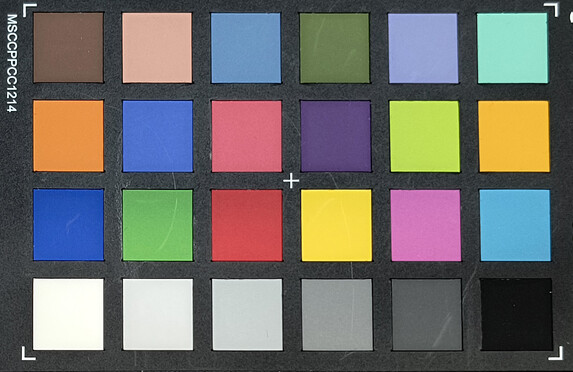
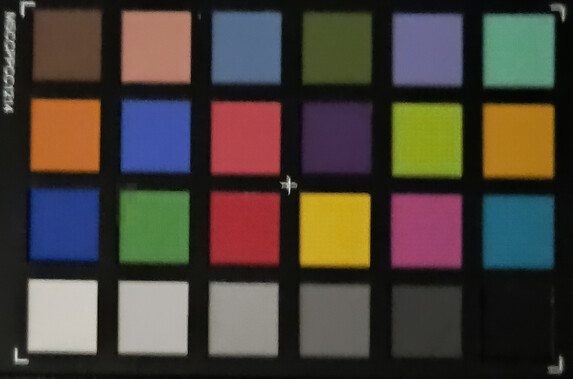
Scope of delivery and warranty – Everything important is included
The phone comes delivered with a 68-watt charger as well as a protective case, a USB-C cable and a SIM tool.
Motorola offers a 24-month warranty for phones purchased in the EU — for US phones, they are covered for 12 months. There are extension options available via Moto Care that include damage cover for one to three years.
Input devices & operation – Fast touchscreen
The touchscreen responds to touches up to 360 times per second and as a result, is very reactive. The 144 frames that the screen can display per second also mean that the system responds very promptly to inputs.
The fingerprint sensor is located behind the screen and is placed very far down so that even people with small hands can reach it easily. Unlocking with saved fingerprints works very well. However, it takes a second until the system reacts to the finger.
Unlocking via facial recognition is also possible. This also works smoothly using the front-facing camera. However, only 2D images are used, so manipulation by third parties cannot be completely ruled out.
Display – Very bright and very fast
The Edge 40 Neo's screen relies on OLED technology and features enhanced Full HD resolution. Its maximum refresh rate of 144 Hz is impressive and rarely seen in this price range. However, it isn't entirely clear whether you can truly notice the difference between 120 Hz and 144 Hz.
Its 6.55-inch screen can get very bright — with the light sensor illuminated, we measured an average of 957 cd/m² when depicting a full white screen and 1,265 cd/m² when depicting a small lit area (APL 18). This also makes it well-suited for HDR content.
| |||||||||||||||||||||||||
Brightness Distribution: 97 %
Center on Battery: 966 cd/m²
Contrast: ∞:1 (Black: 0 cd/m²)
ΔE ColorChecker Calman: 1.87 | ∀{0.5-29.43 Ø4.78}
ΔE Greyscale Calman: 2.5 | ∀{0.09-98 Ø5}
97.7% sRGB (Calman 2D)
Gamma: 2.272
CCT: 6582 K
| Motorola Edge 40 Neo pOLED, 2400x1080, 6.6" | Motorola Edge 30 Neo pOLED, 2400x1080, 6.3" | Honor Magic5 Lite 5G AMOLED, 2400x1080, 6.7" | Xiaomi 13 Lite AMOLED, 2400x1080, 6.6" | Sony Xperia 10 V OLED, 2520x1080, 6.1" | |
|---|---|---|---|---|---|
| Screen | 2% | 11% | 13% | 21% | |
| Brightness middle (cd/m²) | 966 | 984 2% | 846 -12% | 905 -6% | 933 -3% |
| Brightness (cd/m²) | 957 | 992 4% | 853 -11% | 904 -6% | 944 -1% |
| Brightness Distribution (%) | 97 | 98 1% | 88 -9% | 99 2% | 97 0% |
| Black Level * (cd/m²) | |||||
| Colorchecker dE 2000 * | 1.87 | 1.6 14% | 1.3 30% | 1 47% | 1.1 41% |
| Colorchecker dE 2000 max. * | 4.34 | 3.8 12% | 2.7 38% | 3 31% | 1.7 61% |
| Greyscale dE 2000 * | 2.5 | 3 -20% | 1.7 32% | 2.2 12% | 1.8 28% |
| Gamma | 2.272 97% | 2.14 103% | 2.19 100% | 2.23 99% | 2.29 96% |
| CCT | 6582 99% | 6518 100% | 6570 99% | 6382 102% | 6611 98% |
* ... smaller is better
Screen Flickering / PWM (Pulse-Width Modulation)
| Screen flickering / PWM detected | 120.4 Hz | ||
The display backlight flickers at 120.4 Hz (worst case, e.g., utilizing PWM) . The frequency of 120.4 Hz is very low, so the flickering may cause eyestrain and headaches after extended use. In comparison: 53 % of all tested devices do not use PWM to dim the display. If PWM was detected, an average of 8108 (minimum: 5 - maximum: 343500) Hz was measured. | |||
Measurement series with fixed zoom level and different brightness settings
We also really liked the phone's precise color depiction, which we measured using a spectral photometer and the software CalMAN. We used the color setting "natural". You can't perceive a color tint within the light gray tones with the naked eye and the colors aren't far from perfect, either.
The PWM flickering used to dim the display is adapted to the screen's refresh rate. This might make it a little less of a disturbance but even so, we would recommend that sensitive users try out the phone before purchasing.
Display Response Times
| ↔ Response Time Black to White | ||
|---|---|---|
| 1.1 ms ... rise ↗ and fall ↘ combined | ↗ 0.6 ms rise | |
| ↘ 0.5 ms fall | ||
| The screen shows very fast response rates in our tests and should be very well suited for fast-paced gaming. In comparison, all tested devices range from 0.1 (minimum) to 240 (maximum) ms. » 4 % of all devices are better. This means that the measured response time is better than the average of all tested devices (20.2 ms). | ||
| ↔ Response Time 50% Grey to 80% Grey | ||
| 1.6 ms ... rise ↗ and fall ↘ combined | ↗ 0.8 ms rise | |
| ↘ 0.8 ms fall | ||
| The screen shows very fast response rates in our tests and should be very well suited for fast-paced gaming. In comparison, all tested devices range from 0.165 (minimum) to 636 (maximum) ms. » 7 % of all devices are better. This means that the measured response time is better than the average of all tested devices (31.6 ms). | ||
Performance – A modern SoC with lots of power
The Motorola phone uses the relatively up-to-date MediaTek Dimensity 7030 as its SoC. The processor part clocks at up to 2.5 GHz and showed itself to be very fast during our benchmarks. Our test sample may have not been able to keep up with the Xiaomi 13 Lite, but in comparison to other similarly priced smartphones, it offers a lot of power for the price.
In everyday use, you can manoeuvre through the system smoothly and even more demanding tasks pose no issues for the system. Only high loads and multiple simultaneous tasks push the Motorola Edge 40 Neo to its performance limits.
| Antutu v9 - Total Score | |
| Average of class Smartphone (99654 - 2056989, n=28, last 2 years) | |
| Xiaomi 13 Lite | |
| Motorola Edge 40 Neo | |
| Average MediaTek Dimensity 7030 (n=1) | |
| Motorola Edge 30 Neo | |
| Sony Xperia 10 V | |
| UL Procyon AI Inference for Android - Overall Score NNAPI | |
| Xiaomi 13 Lite | |
| Motorola Edge 40 Neo | |
| Average MediaTek Dimensity 7030 (n=1) | |
| Average of class Smartphone (3769 - 81594, n=139, last 2 years) | |
| Motorola Edge 30 Neo | |
| Sony Xperia 10 V | |
| AImark - Score v3.x | |
| Xiaomi 13 Lite | |
| Average of class Smartphone (82 - 307528, n=125, last 2 years) | |
| Motorola Edge 40 Neo | |
| Average MediaTek Dimensity 7030 (n=1) | |
| Sony Xperia 10 V | |
The smartphone uses an ARM Mali-G610MP3 as a GPU. Although it is very up-to-date, the also relatively new 3DMark Solar Bay refused to run, stating missing features on the graphics card as its reason for this.
The graphics card is too slow for calculations in 4K or 1440p, as our benchmarks revealed. In 1080p, it should still be good enough for graphically demanding uses at 30 fps.
GFXBench (DX / GLBenchmark) 2.7: T-Rex Onscreen | 1920x1080 T-Rex Offscreen
GFXBench 3.0: on screen Manhattan Onscreen OGL | 1920x1080 1080p Manhattan Offscreen
GFXBench 3.1: on screen Manhattan ES 3.1 Onscreen | 1920x1080 Manhattan ES 3.1 Offscreen
GFXBench: on screen Car Chase Onscreen | 1920x1080 Car Chase Offscreen | on screen Aztec Ruins High Tier Onscreen | 2560x1440 Aztec Ruins High Tier Offscreen | on screen Aztec Ruins Normal Tier Onscreen | 1920x1080 Aztec Ruins Normal Tier Offscreen | 3840x2160 4K Aztec Ruins High Tier Offscreen
| 3DMark / Wild Life Extreme Unlimited | |
| Xiaomi 13 Lite | |
| Motorola Edge 40 Neo | |
| Motorola Edge 30 Neo | |
| Sony Xperia 10 V | |
| Honor Magic5 Lite 5G | |
| 3DMark / Wild Life Extreme | |
| Xiaomi 13 Lite | |
| Motorola Edge 40 Neo | |
| Motorola Edge 30 Neo | |
| Honor Magic5 Lite 5G | |
| Sony Xperia 10 V | |
| 3DMark / Wild Life Unlimited Score | |
| Xiaomi 13 Lite | |
| Motorola Edge 40 Neo | |
| Motorola Edge 30 Neo | |
| Honor Magic5 Lite 5G | |
| Sony Xperia 10 V | |
| 3DMark / Wild Life Score | |
| Xiaomi 13 Lite | |
| Motorola Edge 40 Neo | |
| Honor Magic5 Lite 5G | |
| Motorola Edge 30 Neo | |
| Sony Xperia 10 V | |
| 3DMark / Sling Shot Extreme (Vulkan) Unlimited Physics | |
| Xiaomi 13 Lite | |
| Motorola Edge 40 Neo | |
| Motorola Edge 30 Neo | |
| 3DMark / Sling Shot Extreme (Vulkan) Unlimited Graphics | |
| Xiaomi 13 Lite | |
| Motorola Edge 40 Neo | |
| Motorola Edge 30 Neo | |
| 3DMark / Sling Shot Extreme (Vulkan) Unlimited | |
| Xiaomi 13 Lite | |
| Motorola Edge 40 Neo | |
| Motorola Edge 30 Neo | |
| 3DMark / Sling Shot Extreme (ES 3.1) Unlimited Physics | |
| Motorola Edge 40 Neo | |
| Honor Magic5 Lite 5G | |
| Sony Xperia 10 V | |
| Xiaomi 13 Lite | |
| Motorola Edge 30 Neo | |
| 3DMark / Sling Shot Extreme (ES 3.1) Unlimited Graphics | |
| Xiaomi 13 Lite | |
| Motorola Edge 40 Neo | |
| Honor Magic5 Lite 5G | |
| Sony Xperia 10 V | |
| Motorola Edge 30 Neo | |
| 3DMark / Sling Shot Extreme (ES 3.1) Unlimited | |
| Xiaomi 13 Lite | |
| Motorola Edge 40 Neo | |
| Honor Magic5 Lite 5G | |
| Sony Xperia 10 V | |
| Motorola Edge 30 Neo | |
| GFXBench (DX / GLBenchmark) 2.7 / T-Rex Onscreen | |
| Xiaomi 13 Lite | |
| Motorola Edge 40 Neo | |
| Sony Xperia 10 V | |
| GFXBench (DX / GLBenchmark) 2.7 / T-Rex Offscreen | |
| Xiaomi 13 Lite | |
| Motorola Edge 40 Neo | |
| Sony Xperia 10 V | |
| GFXBench 3.0 / Manhattan Onscreen OGL | |
| Xiaomi 13 Lite | |
| Motorola Edge 40 Neo | |
| Motorola Edge 30 Neo | |
| Sony Xperia 10 V | |
| GFXBench 3.0 / 1080p Manhattan Offscreen | |
| Xiaomi 13 Lite | |
| Motorola Edge 40 Neo | |
| Motorola Edge 30 Neo | |
| Sony Xperia 10 V | |
| GFXBench 3.1 / Manhattan ES 3.1 Onscreen | |
| Xiaomi 13 Lite | |
| Motorola Edge 40 Neo | |
| Motorola Edge 30 Neo | |
| Sony Xperia 10 V | |
| GFXBench 3.1 / Manhattan ES 3.1 Offscreen | |
| Xiaomi 13 Lite | |
| Motorola Edge 40 Neo | |
| Motorola Edge 30 Neo | |
| Sony Xperia 10 V | |
| GFXBench / Car Chase Onscreen | |
| Xiaomi 13 Lite | |
| Motorola Edge 40 Neo | |
| Motorola Edge 30 Neo | |
| Sony Xperia 10 V | |
| GFXBench / Car Chase Offscreen | |
| Xiaomi 13 Lite | |
| Motorola Edge 40 Neo | |
| Sony Xperia 10 V | |
| Motorola Edge 30 Neo | |
| GFXBench / Aztec Ruins High Tier Onscreen | |
| Xiaomi 13 Lite | |
| Motorola Edge 40 Neo | |
| Motorola Edge 30 Neo | |
| Honor Magic5 Lite 5G | |
| Sony Xperia 10 V | |
| GFXBench / Aztec Ruins High Tier Offscreen | |
| Xiaomi 13 Lite | |
| Motorola Edge 40 Neo | |
| Motorola Edge 30 Neo | |
| Honor Magic5 Lite 5G | |
| Sony Xperia 10 V | |
| GFXBench / Aztec Ruins Normal Tier Onscreen | |
| Xiaomi 13 Lite | |
| Motorola Edge 40 Neo | |
| Motorola Edge 30 Neo | |
| Honor Magic5 Lite 5G | |
| Sony Xperia 10 V | |
| GFXBench / Aztec Ruins Normal Tier Offscreen | |
| Xiaomi 13 Lite | |
| Motorola Edge 40 Neo | |
| Motorola Edge 30 Neo | |
| Honor Magic5 Lite 5G | |
| Sony Xperia 10 V | |
| GFXBench / 4K Aztec Ruins High Tier Offscreen | |
| Xiaomi 13 Lite | |
| Motorola Edge 40 Neo | |
| Motorola Edge 30 Neo | |
| Honor Magic5 Lite 5G | |
| Sony Xperia 10 V | |
When surfing the web, the Motorola phone proved to be super fast for its price class during our benchmarks.
Even so, large internet pages take a moment to load and images sometimes take a little to appear when you are scrolling, too.
| Jetstream 2 - 2.0 Total Score | |
| Average of class Smartphone (23.8 - 387, n=153, last 2 years) | |
| Average MediaTek Dimensity 7030 (n=1) | |
| Motorola Edge 40 Neo (Chrome 118) | |
| Sony Xperia 10 V (Chrome 116) | |
| Xiaomi 13 Lite (Chrome 111.0.5563.115) | |
| Motorola Edge 30 Neo (Chrome 106) | |
| Speedometer 2.0 - Result 2.0 | |
| Average of class Smartphone (15.2 - 643, n=126, last 2 years) | |
| Motorola Edge 40 Neo (Chrome 118) | |
| Average MediaTek Dimensity 7030 (n=1) | |
| Sony Xperia 10 V (Chrome 116) | |
| Xiaomi 13 Lite (Chrome 111.0.5563.115) | |
| WebXPRT 4 - Overall | |
| Average of class Smartphone (27 - 306, n=149, last 2 years) | |
| Motorola Edge 40 Neo (Chrome 118) | |
| Average MediaTek Dimensity 7030 (n=1) | |
| Xiaomi 13 Lite (Chrome 111.0.5563.115) | |
| Motorola Edge 30 Neo (chrome 106) | |
| Sony Xperia 10 V (Chrome 116) | |
| WebXPRT 3 - Overall | |
| Average of class Smartphone (38 - 380, n=34, last 2 years) | |
| Motorola Edge 40 Neo (Chrome 118) | |
| Average MediaTek Dimensity 7030 (n=1) | |
| Xiaomi 13 Lite (Chrome 111.0.5563.115) | |
| Octane V2 - Total Score | |
| Average of class Smartphone (2228 - 121337, n=201, last 2 years) | |
| Motorola Edge 40 Neo (Chrome 118) | |
| Average MediaTek Dimensity 7030 (n=1) | |
| Sony Xperia 10 V (Chrome 116) | |
| Xiaomi 13 Lite (Chrome 111.0.5563.115) | |
| Motorola Edge 30 Neo (chrome 106) | |
| Honor Magic5 Lite 5G (Chrome 112) | |
| Mozilla Kraken 1.1 - Total | |
| Motorola Edge 30 Neo (chrome 106) | |
| Sony Xperia 10 V (Chrome 116) | |
| Xiaomi 13 Lite (Chrome 111.0.5563.115) | |
| Motorola Edge 40 Neo (Chrome 118) | |
| Average MediaTek Dimensity 7030 (n=1) | |
| Average of class Smartphone (257 - 28190, n=156, last 2 years) | |
* ... smaller is better
Thanks to its UFS 3.1 flash, the Motorola Edge 40 Neo proves to be very fast. Even though the even faster UFS 4.0 can already be found in high-end phones, this phone can make do without: Loading times are short and data transfers are completed in no time.
| Motorola Edge 40 Neo | Motorola Edge 30 Neo | Honor Magic5 Lite 5G | Xiaomi 13 Lite | Sony Xperia 10 V | Average 256 GB UFS 3.1 Flash | Average of class Smartphone | |
|---|---|---|---|---|---|---|---|
| AndroBench 3-5 | -44% | -49% | -0% | -47% | 30% | 61% | |
| Sequential Read 256KB (MB/s) | 1004.4 | 498.82 -50% | 486.17 -52% | 1001.82 0% | 444.54 -56% | 1757 ? 75% | 2226 ? 122% |
| Sequential Write 256KB (MB/s) | 930.9 | 469.52 -50% | 420.44 -55% | 871.96 -6% | 438.02 -53% | 1204 ? 29% | 1848 ? 99% |
| Random Read 4KB (MB/s) | 279.5 | 180.19 -36% | 171.13 -39% | 277.33 -1% | 175.72 -37% | 287 ? 3% | 295 ? 6% |
| Random Write 4KB (MB/s) | 284.1 | 169.19 -40% | 149.12 -48% | 301.41 6% | 165.15 -42% | 318 ? 12% | 335 ? 18% |
Games – 60 fps are possible
Our gaming tests proved to be just as fun for the Motorola Edge 40 Neo as they were for us: It managed to bring smooth movements onto its screen, sometimes even allowing for higher graphics settings.
True 60 fps are only really possible at the expense of quite a lot of detail and when running Genshin Impact, we only measured 40 fps. However, this frame rate did remain quite consistent. You can manage at least 30 fps with very high settings. We measured these frame rates using the software from GameBench.
Controlling the games via the phone's precise touchscreen also works well. And when necessary, the position sensor also proves to be a reliable controller.
Emissions – A hothead, but without any throttling
Temperature
The Motorola smartphone can get quite hot when it runs under full load for a longer period of time: We measured up to 46.9 °C in room temperature conditions — on warm days, it can get even hotter. This is definitely noticeable and might get a little uncomfortable.
However, the SoC didn't seem to be swayed by this: It still produced very similar results in the 3DMark stress tests, even after 20 runs of the same benchmark.
(-) The maximum temperature on the upper side is 46.9 °C / 116 F, compared to the average of 35.2 °C / 95 F, ranging from 21.9 to 247 °C for the class Smartphone.
(-) The bottom heats up to a maximum of 47.9 °C / 118 F, compared to the average of 34 °C / 93 F
(+) In idle usage, the average temperature for the upper side is 22.6 °C / 73 F, compared to the device average of 32.9 °C / 91 F.
3DMark Wild Life Stress Test
| 3DMark | |
| Wild Life Stress Test Stability | |
| Honor Magic5 Lite 5G | |
| Sony Xperia 10 V | |
| Xiaomi 13 Lite | |
| Motorola Edge 30 Neo | |
| Motorola Edge 30 Neo | |
| Motorola Edge 40 Neo | |
| Wild Life Extreme Stress Test | |
| Xiaomi 13 Lite | |
| Motorola Edge 40 Neo | |
| Motorola Edge 30 Neo | |
| Motorola Edge 30 Neo | |
| Sony Xperia 10 V | |
| Honor Magic5 Lite 5G | |
Speakers
The Motorola Edge 40 Neo's sound system consists of a dedicated speaker on the bottom edge and the earpiece as a support. As a result, it can create slight stereo effects when the phone is held horizontally and the two speakers can become quite powerful. The sound is full and not overdriven, but also a bit treble-heavy.
Movie sound is not terribly fun, but you can hear voices well. If you place a lot of value on audio quality, you can simply connect external speakers or headphones via USB-C or Bluetooth. Almost everything that is currently available in terms of codecs for wireless audio playback is available: SBC, AAC, all aptX variants, LDAC, LC3 and LHDC V1-4.
Motorola Edge 40 Neo audio analysis
(+) | speakers can play relatively loud (83.9 dB)
Bass 100 - 315 Hz
(-) | nearly no bass - on average 28.1% lower than median
(±) | linearity of bass is average (10.4% delta to prev. frequency)
Mids 400 - 2000 Hz
(+) | balanced mids - only 4.8% away from median
(±) | linearity of mids is average (7% delta to prev. frequency)
Highs 2 - 16 kHz
(+) | balanced highs - only 3.9% away from median
(+) | highs are linear (3.5% delta to prev. frequency)
Overall 100 - 16.000 Hz
(±) | linearity of overall sound is average (20.1% difference to median)
Compared to same class
» 32% of all tested devices in this class were better, 9% similar, 59% worse
» The best had a delta of 11%, average was 35%, worst was 134%
Compared to all devices tested
» 51% of all tested devices were better, 8% similar, 41% worse
» The best had a delta of 4%, average was 24%, worst was 134%
Sony Xperia 10 V audio analysis
(+) | speakers can play relatively loud (89.2 dB)
Bass 100 - 315 Hz
(-) | nearly no bass - on average 36% lower than median
(±) | linearity of bass is average (8% delta to prev. frequency)
Mids 400 - 2000 Hz
(+) | balanced mids - only 4.8% away from median
(+) | mids are linear (6% delta to prev. frequency)
Highs 2 - 16 kHz
(+) | balanced highs - only 1.8% away from median
(+) | highs are linear (2% delta to prev. frequency)
Overall 100 - 16.000 Hz
(±) | linearity of overall sound is average (20.4% difference to median)
Compared to same class
» 34% of all tested devices in this class were better, 9% similar, 57% worse
» The best had a delta of 11%, average was 35%, worst was 134%
Compared to all devices tested
» 53% of all tested devices were better, 8% similar, 39% worse
» The best had a delta of 4%, average was 24%, worst was 134%
Battery life – No need to be near an outlet all the time in everyday use
Power consumption
Motorola's Edge 40 Neo needs quite a bit of power under high load, but is also frugal under low load.
The phone can be charged with a maximum of 68 watts, which means that even its generous 5,000 mAh battery can be recharged in less than an hour. The Motorola phone does not support wireless charging.
| Off / Standby | |
| Idle | |
| Load |
|
Key:
min: | |
| Motorola Edge 40 Neo 5000 mAh | Motorola Edge 30 Neo 4020 mAh | Xiaomi 13 Lite 4500 mAh | Sony Xperia 10 V 5000 mAh | Average MediaTek Dimensity 7030 | Average of class Smartphone | |
|---|---|---|---|---|---|---|
| Power Consumption | 11% | 5% | 26% | 0% | -17% | |
| Idle Minimum * (Watt) | 1 | 0.9 10% | 0.74 26% | 0.56 44% | 1 ? -0% | 0.848 ? 15% |
| Idle Average * (Watt) | 1.2 | 1.55 -29% | 1.56 -30% | 0.91 24% | 1.2 ? -0% | 1.434 ? -20% |
| Idle Maximum * (Watt) | 1.3 | 1.56 -20% | 1.59 -22% | 0.98 25% | 1.3 ? -0% | 1.618 ? -24% |
| Load Average * (Watt) | 5.2 | 2.82 46% | 3.33 36% | 5.34 -3% | 5.2 ? -0% | 7.01 ? -35% |
| Load Maximum * (Watt) | 9.2 | 4.97 46% | 7.59 17% | 5.46 41% | 9.2 ? -0% | 11.3 ? -23% |
* ... smaller is better
Power consumption: Geekbench (150 cd/m²)
Power consumption: GFXBench (150 cd/m²)
Runtimes
This phone's battery is a lot more powerful than the one in its predecessor, the Edge 30 Neo. It now has a 5,000 mAh capacity and delivers really good runtimes: In our WLAN test, we measured 14:24 hours, which is enough to easily get you through the day — even if you almost constantly use the phone. If you like to play games, then you can look forward to doing this for about 6 hours before the lights go out.
On the other hand, the Sony Xperia 10 V impressively shows that even more can be done when it comes to power efficiency.
| Motorola Edge 40 Neo 5000 mAh | Motorola Edge 30 Neo 4020 mAh | Honor Magic5 Lite 5G 5100 mAh | Xiaomi 13 Lite 4500 mAh | Sony Xperia 10 V 5000 mAh | |
|---|---|---|---|---|---|
| Battery runtime | -17% | -6% | -6% | 36% | |
| Reader / Idle (h) | 40.7 | 37.3 -8% | 67.8 67% | ||
| H.264 (h) | 20.5 | 19.8 -3% | 26.9 31% | ||
| WiFi v1.3 (h) | 14.4 | 12 -17% | 13.6 -6% | 13.7 -5% | 19.3 34% |
| Load (h) | 5.9 | 5.4 -8% | 6.5 10% |
Pros
Cons
Verdict – A lot of features for comparatively little money
You can find the Motorola Edge 40 Neo for a mere US$550, but it has some big advantages over other similarly priced smartphones: Its 144-Hz screen is super bright and well-suited for HDR content, and its modern SoC offers a lot of power — at times, even enabling gaming at 60 fps.
Adding to this is its fast and large storage, its water-resistant case and its super-fast WLAN with 6 GHz network support. The phone's runtimes are good and the system isn't throttled — even under longer periods of load. Its stock Android is fun but unfortunately, Motorola has also installed quite a few third-party apps.
We did notice some smaller flaws, too: The Edge 40 Neo's location services aren't the best, material transitions on the case are quite noticeable, and safety patches are delivered rather sparingly.
The Motorola Edge 40 Neo offers good value for its money. Especially its fast storage and bright screen are real highlights.
You can also get a very good display and fast charging on the phone's predecessor, the Edge 30 Neo. It is now available for about US$300. The Xiaomi 13 Lite is also more powerful and can be found for around US$450 now.
Price and availability
The version of the Motorola Edge 40 Neo with 12 GB RAM and 256 GB storage can be found on Amazon for about US$550.
Motorola Edge 40 Neo
- 10/24/2023 v7 (old)
Florian Schmitt
Transparency
The selection of devices to be reviewed is made by our editorial team. The test sample was provided to the author as a loan by the manufacturer or retailer for the purpose of this review. The lender had no influence on this review, nor did the manufacturer receive a copy of this review before publication. There was no obligation to publish this review. As an independent media company, Notebookcheck is not subjected to the authority of manufacturers, retailers or publishers.
This is how Notebookcheck is testing
Every year, Notebookcheck independently reviews hundreds of laptops and smartphones using standardized procedures to ensure that all results are comparable. We have continuously developed our test methods for around 20 years and set industry standards in the process. In our test labs, high-quality measuring equipment is utilized by experienced technicians and editors. These tests involve a multi-stage validation process. Our complex rating system is based on hundreds of well-founded measurements and benchmarks, which maintains objectivity. Further information on our test methods can be found here.




